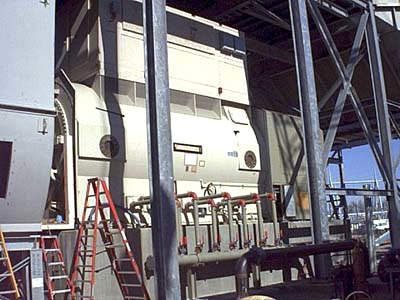Contents
Molar conductance is defined for a constant concentration of salt and by definition is invariant with different concentrations. Conductance on the other hand is a general purpose term and it is not mentioned without above mentioned qualifiers. Conductivity always decreases with decrease in concentration both, for weak and strong electrolytes because of the fact that ____________. The weak electrolytes dissociate to a much lesser extent as compared to strrong electrolytes. Therefore, the molar conductivity is low as compare of strong electrolytes. However at infinite dilution (i.e., when concentration approaches zero) the conductivity of the solution is so low that it cannot be measured accurately.
One ampere is defined as 1 coulomb of electricity transferred in one second. Volt can be formally defined as the ratio of energy in joules to the charge in coulombs. In a unit cell of NaCl, 12 Na+ions are present at the edge centre and one at the body centre. ” depends on the type of electrolyte at a particular temperature. A. The liquid allows the electric current to pass through. The current will flow from silver to copper in the external circuit.
More Chemistry Questions
Give one difference between the order of a reaction and its molecularity. Difference between conductivity and specific conductivity. Ferrous ions are further oxidised https://1investing.in/ by atmospheric oxygen to ferric ions which combine with water to form hydrated ferric oxide, Fe2O3. Thus, an electrochemical cell is set up on the surface.
- For strong electrolytes, there is no increase in the number of ions with dilution because strong electrolytes are completely ionised in solution at all concentrations .
- Λ°+ and λ°– are also called molar ionic conductances at infinite dilution.
- Or by admixture with solutions or mixtures of lower strength) or are concentrated .
Calculating the amount of a solution of given strength that must be used to prepare a solution of desired amount and strength involves the following. Dilution of a solid or liquid does not entail adding more drug. Therefore, the amount of drug in the diluted product is the same; only the volume is larger. Use the alligation methods to determine relative amounts of components mixed together to make a mixture of a required strength. The smallest value of “free” charge known in nature is the charge of an electron or a proton, which has a magnitude of 1.602 x Coulomb.
Other Related Questions on Physical Chemistry
As with dilution, more ions are produced in solution so conductance also increases on dilution. The conductance of electricity by ions present in the solutions is called electrolytic or ionic conductance. The following factors govern the flow of electricity through a solution of electrolyte. An electrochemical cell is a device that is used to create electrical energy through the chemical reactions which are involved in it.

Therefore, Λo for weak electrolytes is obtained by using Kohlrausch law of independent migration of ions, which is described in the next section. The equivalent conductivity at infinite dilution is known as the limiting equivalent conductivity (Λo). At this dilution, the ionization of even the weak electrolyte is complete. It can be defined as the external work expended per unit of charge to produce an electric potential difference thereby causing the current to flow in the circuit. It is also possible to produce electrical energy by carrying out a spontaneous chemical reaction in a suitable device called galvanic cell or voltaic cell.
Difference between conductivity and specific conductivity.
The limiting value of molar conductance corresponds to degree of dissociation equal to 1 i.e., the whole of the electrolyte dissociates. On dilution the volume of the solution is increasing but the number of ions that carry charge in a solution remains the same. Hence the number of ions per unit volume that carry charge in a solution decreases. As the movement of these charges towards the oppositely charged electrodes causes the flow of current, the conductivity of a solution decreases on dilution. The variation of Λm with concentration, C½ is small so that the plots can be extrapolated to zero concentration. The intercept gives the limiting value of molar conductivity when the concentration approaches zero, called molar conductivity at infinite dilution, Λm.
What is the effect of dilution on an acid or base?
Reason: On dilution, the ratio of concentration of salt and acid (or base) remains unchanged.
The resistance shown by an electrolytic solution is due to factors like interionic attractions, viscosity of solvent etc. The electrolytic conduction will not occur unless the ions of the electrolyte are free to move. Therefore, these substances do not conduct electricity in the solid state but conduct electricity in the molten state or in their aqueous solutions.
Products
Thus, measuring the molar conductance at any concentration (Λc ) helps to calculate degree of dissociation (α) if is known. Molar conductance of a weak electrolyte depends upon its degree of dissociation. Higher the degree of dissociation, larger is the molar conductance. The variation of molar conductivity with concentration can be studied by plotting the values of Λm against square root of concentration (C½).
Also we know that the conductance shown by 1 cm3 solution containing this electrolyte is called specific conductance, κ. However, the variation of Λm with C½ is very large and so much so that we cannot obtain molar conductance at infinite dilution ( Λm°) by extrapolation of Λm versus C½ plots. Equivalent conductivity is the conducting power of all the ions produced by dissolving one gram equivalent of an electrolyte in a solution.
Class 12 NCERT Psychology Solutions
Methane and methanol can also be used as fuels in place of hydrogen in the fuel cells. Suggest a list of metals which a demand curve which drops in stages is called can be extracted electrolytically. Therefore, Λmo cannot be obtained by extrapolation of Λm to zero concentration.
- The variation of molar conductance with concentration can be explained on the basis of conducting ability of ions for weak and strong electrolytes.
- Metallic conduction decreases with increase of temperature.
- In the electrochemical cell, the involved devices have the ability to convert the chemical energy to electrical energy or vice-versa.
- It is the reciprocal of resistance and may be defined as the ease with which the electric current flows through a conductor.
Keeping this in mind, let us predict the feasibility of the reactions. Hence, conductivity of a solution is defined as the conductance of a solution of 1 cm length and having 1 sq. Alternatively, it may be defined as conductance of one centimetre cube of the solution of the electrolyte. Problems such as these sometimes seem complicated and difficult. Solving some of these calculations requires a series of steps. Understanding the basic concepts of dilution and concentration uncomplicates these problems.
This is because that total volume, V, of solution containing one mole of electrolyte also increases. It has been found that decrease in K on dilution of a solution is more than compensated by increase in its volume. In other words, if the amount of active ingredient remains the same and the volume gets larger, the concentration gets smaller. Likewise, if the amount of active ingredient remains the same and the volume gets smaller, the concentration increases. Explain why on dilution does the conductivity decrease whereas molar conductivity increases for an electrolytic solution. Molar conductance is when one mole of salt is added to form the unit volume of solution.
The rate of reaction is affected by nature of reactant and temperature. Enthalpy change and entropy change of a chemical reaction at 25°C are 177.0 KJ and 160.4 JK-1respectively. Calculate free energy change of the reaction and predict whether the reaction is spontaneous or nonspontaneous. In the case of aniline electron withdrawing phenyl group decreases electron density at nitrogen and as a result,it is less basic than ammonia. In the case of methylamine electron donating methyl group increases the electron density at nitrogen and therefore it is basic than ammonia. In this mechanism rate of reaction depends on the concentration of alkyl chloride and KOH both.
Water in itself is not a good conductor but with salts in it, the dissociated ions make the salt solution conducting. As we know that, conductance of ions is due to the presence of ions in the solution. As with dilution, more ions are produced in solution so conductance increases on dilution.




